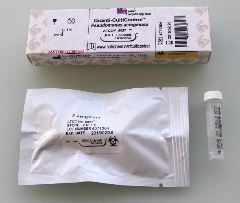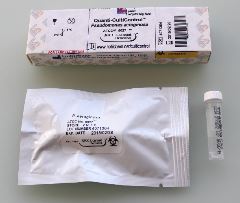(QC routine) ATCC 25922/ NCTC 12241 E COLI, 5 pellets, µtube
Valid Article
ROUTINE QUALITY CONTROL MICROORGANISM
Definition
Phenotypically characterized strains that are developped according to recommendations of/made available by the European Society of Clinical Microbiology and Infectious Diseases (EUCAST) for quality control.
The microbial strains have predictable characteristics and are used routinely to monitor the performance of the laboratory (e.g. culture media, identification tests).
The microbial strain preparations are derived from ATCC® (American Type Culture Collection), NCTC® (National Collection of Type Cultures, operated by the UK Health Security Agency (UKHSA)
Specifications
EUCAST recommendations for principal, for specific agents and routine Quality Control:
- ATCC 29212/NCTC 12697 E FAECALIS
- Enterococcus spp
- ATCC 25922/NCTC 12241 E COLI
- Stenophomonas maltophilia
- Enterobacteriaceae
- Pseudomonas spp
- Acinetobacter spp
- Aeromonas spp
- ATCC 49766/NCTC 12975 H INFLUENZA
- Haemophilus influenzae
- Moraxella catarrhalis
- Pasteurella multocida
- Kingella kingae
- ATCC 27853/NCTC 12903 P AERUGINOSA
- Pseudomonas spp
- Acinetobacter spp
- Aeromonas spp
- ATCC 29213/NCTC 12973 S AUREUS
- Staphylococcus spp
- Aerococcus sanguinicola and urinae
- Corynebacterium spp
- For Beta-lactam-B-lactamase inhibitor combinations
- ATCC 49619/NCTC 12977 S PNEUMONIAE
- Streptococcus groups A, B, C and G
- Streptococcus pneumoniae
- Viridans group streptococci
- Listeria monocytogenes
- Corynebacterium spp
- Aerococcus sanguinicola and urinae
- Pasteurella multocida
- ATCC 35218/NCTC 11954 E COLI
- For Beta-lactam-B-lactamase inhibitor combinations
Quality Standards Comment
EUCAST recommendations - version 8
Components
The quality control microorganisms are packaged in a resealable vial that contains five lyophilized pellets of a single microorganism strain and a desiccant to prevent adverse accumulation of moisture
Technical specifications
- Freeze dried bacterial strains
- Microorganisms for standard protocols should be used within five passages of the ATCC reference culturex
- ATCC: Each lyophilized microorganism preparation is less than or equal to four (4) passages from a reference culture.
- NCTC: Each lyophilized microorganism preparation is one (1) passage from the reference NCTC culture.
Packaging & Labelling
1 vial contains 5 lyophilized pellets
Transport Dangerous Goods
- UN3373
- Class 6.2
- Proper shipping name: Biological substance, Category B
Instructions for use
Please consult the “Bacteriology laboratory procedures and resources” available online via the Laboratory working Group sharepoint page: Laboratory Procedures and Resources https://msfintl.sharepoint.com/sites/msfintlcommunities/LabWG/SitePages/Bacteriology-Laboratory-Resources.aspx
For offline access, contact your laboratory advisor
Precautions for Use
All biological samples must be considered as potentially infectious and handled with the usual precautions (compulsory wearing of gloves, hand washing, etc.)
Storage
- Store between 2°C and 8°C, with desiccant
- Store at -20°C to -80°C after suspension in brain heart infusion broth and glycerol
- Do not use after expiry date
- Shelf life:
- ATCC: 16 months
- NCTC: 24 months
- Guaranteed minimum remaining shelf life at delivery: 1/3 of the total shelf life
Waste management
After use, sterilize the cultures and all contaminated material
Substance with biohazardous characteristics. Please contact your watsan referent for advice on proper disposal.
Detailed hazard and precautionary information can be found in the safety data sheet (SDS).
Signal Word
Biohazard
MSF requirements
Reserved for bacteriology programmes





![[ELABFOBR1--] FORCEPS, BRUCELLE, 14 cm, straight, inox](/web/image/product.template/570435/image_256/%5BELABFOBR1--%5D%20FORCEPS%2C%20BRUCELLE%2C%2014%20cm%2C%20straight%2C%20inox?unique=30fe079)
![[ELABTUCE1SPC] TUBE, CENTRIFUGE, 15 ml, conical bottom, sterile PS crystal](/web/image/product.template/571492/image_256/%5BELABTUCE1SPC%5D%20TUBE%2C%20CENTRIFUGE%2C%2015%20ml%2C%20conical%20bottom%2C%20sterile%20PS%20crystal?unique=7a7ea0a)
![[ELABTUMS20AS] MICROTUBE, 2.0ml, skirted, assembl. attach. screw cap, ster.](/web/image/product.template/569078/image_256/%5BELABTUMS20AS%5D%20MICROTUBE%2C%202.0ml%2C%20skirted%2C%20assembl.%20attach.%20screw%20cap%2C%20ster.?unique=c1eee3d)
![[SBCMBRTHBHIBD] BRAIN HEART INFUSION BROTH, dehydrated, 500g [BD-211059]](/web/image/product.template/572079/image_256/%5BSBCMBRTHBHIBD%5D%20BRAIN%20HEART%20INFUSION%20BROTH%2C%20dehydrated%2C%20500g%20%5BBD-211059%5D?unique=26a6070)
![[SLASGLYC1B1] GLYCEROL, 1 l, bot.](/web/image/product.template/570450/image_256/%5BSLASGLYC1B1%5D%20GLYCEROL%2C%201%20l%2C%20bot.?unique=4732aaf)
![[SBQCKWIKESCO2] ATCC 25922, E COLI, swab [MBL-0335P]](/web/image/product.template/580148/image_256/%5BSBQCKWIKESCO2%5D%20ATCC%2025922%2C%20E%20COLI%2C%20swab%20%5BMBL-0335P%5D?unique=bc25313)